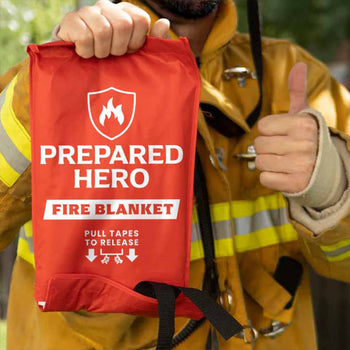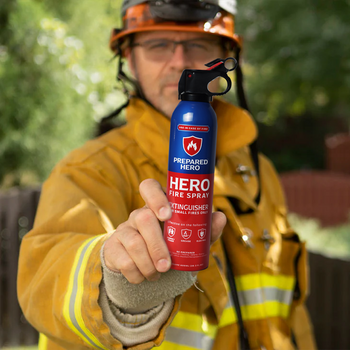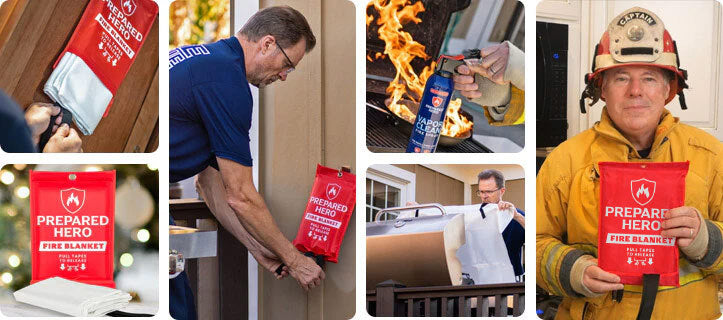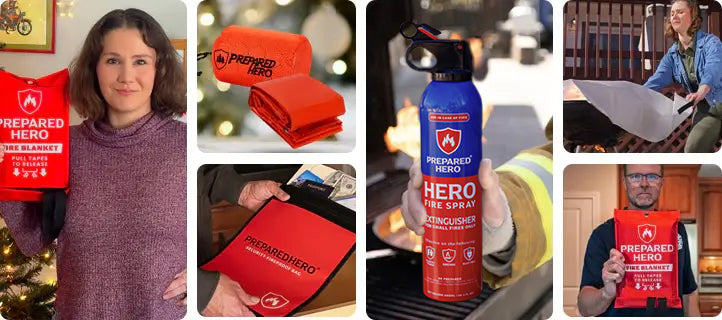Where you put your smoke detectors matters just as much as installing them. Proper placement makes sure they can detect...
According to a study, fires in the US are more than twice as frequent and four times the size compared to previous decades. The unexpected can happen anytime, so being prepared isn’t just an option; it’s a must.
Knowing more about fire safety means learning about the risks and hazards associated with fires. Doing so helps you respond to fire quickly and avoid injury, death, and property damage.
In this post, we’ll talk about the science behind fire, why understanding the risks and hazards associated with fires is important, and how it helps your household and the community.
What Is a Fire Risk?

A fire risk is the likelihood of a fire happening and the harm and consequences caused by the fire. These include fire spread, injuries, property damage, and death.
Many people also think that a fire risk and a fire hazard are the same. They are not. A fire risk is a result of a fire hazard being present. Without a fire hazard, there’s little to no fire risk.
Fire risks also encompass the activities or instances (not the objects) that can lead to a fire. A fire risk assessment, therefore, helps determine the chances of a fire occurring and the harm it can cause to people and properties. Assessors consider the potential for ignition, the competence of the people, the environment, and the condition of the fire hazard.
Fire Risks Associated With Fires
- Unattended Cooking: Frying, baking, or boiling food without paying attention to it increases the chances of a kitchen fire breaking out.
- Electrical Overload: Plugging too many devices or appliances in one socket will probably cause an electrical fire.
- Improper Storage of Flammable Items: Storing flammable liquids and gases near heat sources or a room with little to no ventilation might cause a fire.
- Fire Safety Tool Malfunction: Using non-working smoke alarms and expired fire extinguishers is not safe.
- Smoking Near Heat Sources: Smoking or vaping near heat sources can cause a fire. Think about throwing a cigarette butt without putting it out near a fire pit.
- Putting Heat Equipment Near Combustibles: Placing heating appliances near curtains, bed sheets, or furniture can start a fire.
What Is a Fire Hazard?

A fire hazard is anything that can cause a fire or make it spread. The definition of what counts as a fire hazard has changed over time. An object can now be considered a fire hazard in one context but not another. For instance, a smoke alarm―a fire safety tool― can be a fire hazard if it’s not working properly. For this reason, you should test your smoke alarm regularly to make sure it doesn’t become a fire hazard.
Another example is a pile of cardboard boxes. It might not seem dangerous when stored properly in an area with a fire spray or extinguisher. On the other hand, it becomes a huge fire hazard when stored near a heat source or poorly ventilated space.
It’s also worth noting that fire hazards usually cause fire risks, not the other way around. Fire risks will always involve fire hazards. On the other hand, a fire hazard is still a fire hazard even if there’s little to no fire risk.
Fire Hazards Associated With Fires
- Oils: Cooking oils like vegetable oil and lard can cause intense and fast-spreading fires. They’re a huge fire because many people think water can put out a grease fire when it can’t. Water can spread grease fire and make it explode.
- Curtains: Curtains easily catch flames. The thinner your curtains are, the higher the chance they’ll ignite and burn down your house.
- Candles: Candles easily get knocked over and quickly ignite nearby items like bed sheets, decorations, and documents.
- Fireplaces: About 25,000 chimney fires occur in the US every year. Wood fireplaces can reach up to 2,000 degrees °F and burn flammable items near them.
- Christmas Trees: According to the NFPA, Christmas trees cause an average of 160 fires yearly. The same report states the longer a natural tree is up, the more likely it is to dry out and ignite.
- Sawdust: Contrary to popular belief, sawdust ignites and burns faster than wood logs.
Fire hazards can be found in almost every corner of your home. They can quickly escalate and become uncontrollable, raging infernos. Check out the full list of fire hazards at your home here to be prepared.
Health Impacts of Fire Risks and Hazards

Fires can negatively affect our health in more ways than we might think. From burns to poisoning, the impacts can be long-lasting. Here are the health impacts of fire risks and hazards:
Burns
A fire can burn intensely and release a lot of heat. It can reach up to 3,000°C or 5,432°F. Fire causes tissue injury at 44°C to 70°C, while full tissue destruction occurs above 70°C. Burns can also be life-threatening. Plus, even less intense first- and second-degree burns can be infected and cause scars.
Respiratory Issues
Smoke can cause many respiratory issues. For one, inhaling smoke for extended periods can damage your breathing passages, irritate your lungs, and cause asthma attacks. Plus, extreme heat can burn the mouth and throat. Fire can also make pre-existing conditions like lung disease worse.
Neurological Issues
Smoke from wildfires can trigger brain inflammation, according to scientists. This can persist for more than a month and affects learning and memory. Brain inflammation is the seed for other diseases like dementia, brain development issues, and lifetime mood disorders.
Cardiovascular Issues
Many people think that their heart won’t be affected by smoke. Unfortunately, they’re wrong. Exposure to toxic smoke can cause irregular heartbeats, worsen heart failure, and trigger cardiovascular complications.
Mental Health Issues
Fires negatively impact the mental health of victims, their families, and responders. These effects can also be delayed and can persist for years. Imagine losing your house because of a fire and starting with nothing.
Why Is Understanding the Risks and Hazards Associated With Fires Important?

Understanding the risks and hazards associated with fires is important because it can help save lives, prevent fire, protect properties, educate people, and make communities more resilient. Here’s a more detailed look at why understanding the risks and hazards associated with fires is important:
Saving Lives
The primary goal of understanding the risks and hazards associated with fires is saving lives. Doing so helps households and companies make evacuation plans and fire safety protocols to minimize fire-related injuries and deaths.
Fire Prevention
Understanding the risks and hazards associated with fires helps households, offices, and communities identify potential fire hazards and the risks that come with them. For instance, knowing that overloaded outlets can cause fires encourages people not to plug many devices or appliances into a socket at once.
Protecting Properties
Fires cause an estimated property damage worth $18 billion every year. Understanding the risks and hazards associated with fires helps home and business owners protect their properties from damage. While fire insurance helps, not having to use it is better.
Education and Awareness
Understanding the risks and hazards associated with fires helps households and offices know more about fire safety. This knowledge empowers people to make fire exit strategies and recognize fire risks and hazards around them. It also promotes fire prevention activities like fire drills and fire safety training.
Community Resilience
Understanding the risks and hazards associated with fires also helps communities. When local organizations, fire departments, and residents know the risks and hazards around them, they can create better support systems that improve preparedness and response during fire emergencies. This helps communities bounce back more quickly from fires.
Conclusion
Understanding the risks and hazards associated with fires helps homeowners, office workers, and communities. It helps us recognize potential dangers, prevent fires, and know how to respond if one occurs. By being aware and prepared, we can save lives, protect our homes, and build stronger, more resilient communities.
Remember, it's always better to be safe than sorry. Although we can’t foresee where or when a fire will start, we can be ready if it does. Assembling a fire kit with an emergency fire blanket, fire spray, fire protection gloves, and a smoke mask helps a lot. Go to Prepared Hero and shop for fire safety tools now!


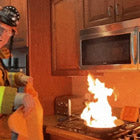 Fire
Fire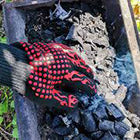 Safety
Safety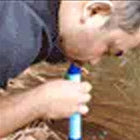 Survival
Survival Protection
Protection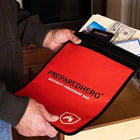 New
New
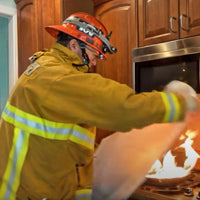 Fire
Fire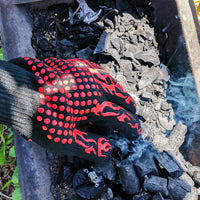 Safety
Safety Survival
Survival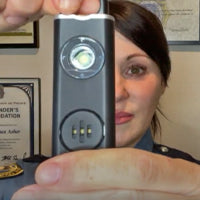 Protection
Protection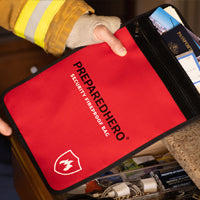 New
New
